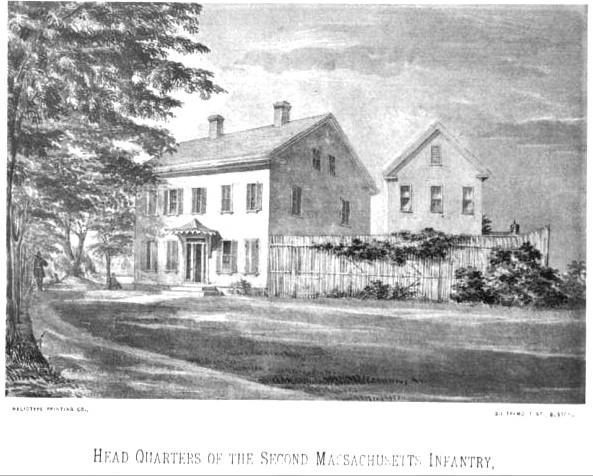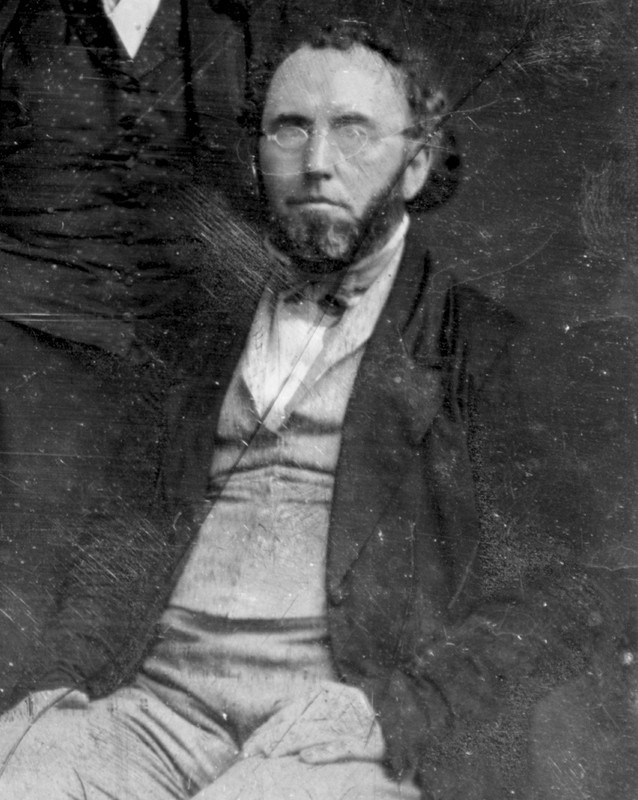Brook Farm
Introduction
Text-to-speech Audio
Brook Farm was the site of an experimental utopia managed by the society of Transcendentalists who lived there in the 1840s. It was one of the first secular utopian communities established in 19th century America, and was later used as a Civil War training camp, a Lutheran orphanage, and a cemetery. In 1965 the landscape was added to the List of National Historic Landmarks in Boston.
Images
Brook Farm with Rainbow by Josiah Wolcott, 1845 (http://www.masshist.org/)

Brook Farm, by Josiah Wolcott, 1844 (http://www.masshist.org/)

Brook Farm during its use as Camp Andrew (commons.wikimedia.org)

George Ripley (commons.wikimedia.org)

Backstory and Context
Text-to-speech Audio
Transcendentalist Experiment in the 1840s
The Transcendentalist movement was influenced by the writings of the English poet Samuel Taylor Coleridge and the German philosophers Immanuel Kant and Friedrich Wilhelm Joseph Schelling. It had its American origins in the Hedge's Club, an intellectual theological group critical of the Unitarian and Trinitarian churches that first met in Boston in September, 1836, and whose members included Ralph Waldo Emerson, Henry David Thoreau, Nathaniel Hawthorne, Fredrick Henry Hedge, and George Ripley, a Unitarian minister. Eager to put their thoughts into practice, in October, 1841, George Ripley purchased the Ellis Farm - a dairy farm in West Roxbury - at a cost of about $30,000, to be used as an agricultural commune by a group that became known as the Transcendental Club.Ellis Farm was renamed as as the Brook Farm Institute of Agriculture and Education when the first sixteen members of the Transcendental Club moved . The 179 acre land included a farmhouse and various outbuildings. The two-and-a-half story farmhouse of white clapboard became known as "The Hive", and served as the main hub at which the members of the Transcendental Club lived, ate, and gathered for discussions. There was a barn built beside the farmhouse, and across the street was a house at which the residents of Brook Farm ran a school of progressive thought based on their approach to "plain living and high thinking," which became known as "The Nest". In 1842 a number of new buildings were established in the landscape.The "Pilgrim House" was a workshop containing a the printing press for The Harbinger, a journal which focused on social reform published by Ripley and the other Transcendentalists. The Margaret Fuller Cottage was located nearby, on the slopes of the highest hill, which led up to the Eyrie (where Ripley resided). A utopian-inspired Phalanstery was also built on the site between 1844 and 1846, which contained an assembly hall, secluded spaces for study, a dining hall, and a bakery. However, as soon as the building was completed in 1846 a fire broke out and destroyed the entire structure.
The residents of Brook Farm earned an income by farming, tuition fees for the pupils of "The Nest", and by manufacturing oil lamps and other pewter ware (the Transcendental Club also sold shares as $500 each). There were people of diverse professions who resided on the farm, and members of the commune were free to pick up new roles on a whim. Farmers, carpenters, writers, printers, cobblers, and a range of domestic roles all existed on the farm. The followed a temperate lifestyle, in terms of diet and entertainment.
Despite consisting of hardworking and motivated members, the Transcendental Club faced regular financial problems following failed agricultural and horticultural ventures. Ownership of the farm transferred between members of the Transcendental Club until 1855, when it was sold to the “Association of the Evangelical Lutheran Church for Works of Mercy”.
Later uses of the landscape
In the 1850s the landscape was briefly used as a poor farm, before it was renamed in 1861 as Camp Andrew and used for the training of the Second Massachusetts Infantry during the Civil War. In 1872 an orphanage was established at the farm by the “Association of the Evangelical Lutheran Church for Works of Mercy”, who were led by Gottlieb F. Burkhardt. The following year the Gethsemane Cemetery was founded. The orphanage closed in 1943, and five years later a residential treatment center and school run by the Lutherans were established. These remained in use until 1974. Ownership of the landscape was transferred to the Commonwealth of Massachusetts in 1988, and has since been managed by the Department of Conservation and Recreation.Brook Farm Today
The farm is situated in more than one hundred and seventy acres of sprawling meadows, woodland, and wetland, which makes for excellent hiking. Guided tours are available throughout the year - check on the links below or phone the above telephone number for more details. The Massachusetts Historical Society, based in Boylston Street, Boston, has preserved some of the most important documents of Brook Farm's history, including letters written its residents, the constitution and minutes of their meetings, and ledgers containing information on the daily purchases and sales for the community.Sources
http://www.newtonconservators.org/photos/brookfarm/campandrew800.jpg
http://www.mass.gov/eea/docs/dcr/parks/boston/brookfarmbrochure.pdf
https://jewettc.wikispaces.com/TTH+3.30+-+Brook+Farm
http://archive.vcu.edu/english/engweb/transcendentalism/ideas/brhistory.html
http://focus.nps.gov/GetAsset?assetID=ce05d300-5ab4-4aa9-8bba-ccc3c48a9ab7
